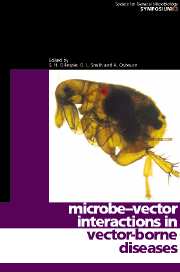Book contents
- Frontmatter
- Contents
- Contributors
- Editors' Preface
- 1 Vector-borne diseases
- 2 Evolution of tick-borne disease systems
- 3 Insect transmission of viruses
- 4 RNA-based immunity in insects
- 5 Specificity of Borrelia–tick vector relationships
- 6 Bunyavirus/mosquito interactions
- 7 How do mosquito vectors live with their viruses?
- 9 Vector competence
- 9 Environmental influences on arbovirus infections and vectors
- 10 Vector immunity
- 11 Transmission of plant viruses by nematodes
- 12 Wolbachia host–symbiont interactions
- 13 Pathogenic strategies of Anaplasma phagocytophilum, a unique bacterium that colonizes neutrophils
- 14 Interactions of Yersinia pestis with its flea vector that lead to the transmission of plague
- 15 Transgenic malaria
- 16 Vaccines targeting vectors
- Index
14 - Interactions of Yersinia pestis with its flea vector that lead to the transmission of plague
Published online by Cambridge University Press: 06 July 2010
- Frontmatter
- Contents
- Contributors
- Editors' Preface
- 1 Vector-borne diseases
- 2 Evolution of tick-borne disease systems
- 3 Insect transmission of viruses
- 4 RNA-based immunity in insects
- 5 Specificity of Borrelia–tick vector relationships
- 6 Bunyavirus/mosquito interactions
- 7 How do mosquito vectors live with their viruses?
- 9 Vector competence
- 9 Environmental influences on arbovirus infections and vectors
- 10 Vector immunity
- 11 Transmission of plant viruses by nematodes
- 12 Wolbachia host–symbiont interactions
- 13 Pathogenic strategies of Anaplasma phagocytophilum, a unique bacterium that colonizes neutrophils
- 14 Interactions of Yersinia pestis with its flea vector that lead to the transmission of plague
- 15 Transgenic malaria
- 16 Vaccines targeting vectors
- Index
Summary
YERSINIA PESTIS, A NEWLY EMERGED ARTHROPOD-BORNE AGENT
Bacterial pathogens transmitted by blood-feeding arthropods present serious public health problems worldwide and new ones continue to be recognized, for example the agents of Lyme disease, ehrlichiosis and cat scratch disease. Arthropod-borne transmission is relatively rare among the prokaryotes, but has evolved independently in a phylogenetically diverse group of eubacteria, including the rickettsiae, spirochaetes in the genus Borrelia, and the Gram-negative or proteobacteria Yersinia pestis and Francisella tularensis.
Y. pestis, the agent of plague, produces a cyclic infection of rodents and their fleas in many parts of the world. Maintenance of Y. pestis in nature depends on these rodent–flea–rodent transmission cycles, although it can also be transmitted in some cases by aerosol, direct contact or ingestion (Poland & Barnes, 1979). The disease produces periodic eruptive, rapidly spreading epizootics among certain highly susceptible rodents, followed by regression to focal areas (Barnes, 1982). Historic human plague pandemics exhibit this same pattern. Other species of wild rodents are more resistant to overt disease, and these species are thought to constitute ecologically important reservoir hosts (Kartman et al., 1958). Human plague remains an international public health concern, and recent outbreaks in India and parts of Africa, where the disease had been dormant for decades, suggest a resurgence (Chanteau et al., 1998).
More troubling is the isolation of multi-drug-resistant strains of Y. pestis during the current epidemic in Madagascar (Galimand et al., 1997). These considerations, and the recognized potential of Y. pestis as a bioterrorism agent, underline the need for a detailed understanding of plague transmission and pathogenicity, which hopefully will bring about new effective vaccines and other control measures.
- Type
- Chapter
- Information
- Microbe-vector Interactions in Vector-borne Diseases , pp. 331 - 344Publisher: Cambridge University PressPrint publication year: 2004
- 3
- Cited by



